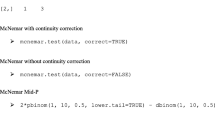Abstract
We explore the power of the twin study to resolve sources of familial resemblance when the data are measured at the binary or ordinal level. Four components of variance were examined: additive genetic, nonadditive genetic, and common and specific environment. Curves are presented to compare the power of the continuous case with those of threshold models corresponding to different prevalences in the population: 1, 5, 10, 25, and 50%. Approximately three times the sample size is needed for equivalent power to the continuous case when the threshold is at the optimal 50%, and this ratio increases to about 10 times when 10% are above threshold. Some power may be recovered by subdividing those above threshold to form three or more ordered classes, but power is determined largely by the lowest threshold. Non-random ascertainment of twins (i) through affected twins and examining their cotwins or (ii) through ascertainment of all pairs in which at least one twin is affected increases power. In most cases, strategy i is more efficient than strategy ii. Though powerful for the rarer disorders, these methods suffer the disadvantage that they rely on prior knowledge of the population prevalence. Furthermore, sampling from hospital cases may introduce biases, reducing their value. A useful approach may be to assess the population with a screening instrument; the power calculations indicate that sampling all concordant and half of the discordant pairs would be efficient, as along as the cost of screening is not too high.
Similar content being viewed by others
References
Agresti, A. (1990).Categorical Data Analysis, Wiley, New York.
Browne, M. W. (1984). Asymptotically distribution-free methods for the analysis of covariance structures.Br. J. Math. Stat. Psychol. 37:62–83.
DeFries, J. C., and Fulker, D. W. (1985). Multiple regression analysis of twin data.Behav. Genet. 15:467–474.
Eaves, L. J. (1969). The genetic analysis of continuous variation: A comparison of experimental designs applicable to human data.Br. J. Math. Stat. Psychol. 22:131–147.
Eaves, L. J. (1972). Computer simulation of sample size and experimental design in human psychogenetics.Psychol. Bull. 77:144–152.
Falconer, D. S. (1960).Quantitative Genetics, Oliver and Boyd, Edinburgh.
Haynam, G. E., Govindarajulu, Z., and Leone, F. C. (1970). Tables of the cumulative non-central chi-square distribution. InSelected Tables in Mathematical Statistics, Vol. 1, American Mathematical Society, Providence, RI.
Heath, A. C., and Eaves, L. J. (1985). Resolving the effects of phenotype and social background on mate selection.Behav. Genet. 15:15–30.
IMSL (1987).IMSL User's Manual. Version 1.0, IMSL, Inc., Houston, TX.
Jöreskog, K. G., and Sörbom, D. (1993).New Features in PRELIS 2, Chicago: Scientific Software International.
Kendler, K. S., Heath, A. C., Neale, M. C., Kessler, R. C., and Eaves, L. J. (1992). A population-based twin study of alcoholism in women.JAMA 268:1877–1882.
Kendler, K. S., Neale, M. C., Kessler, R. C., Heath, A. C., and Eaves, L. J. (1993a). A longitudinal study of one-year prevalence of major depression in women.Arch. Gen. Psychiat. 50:853–862.
Kendler, K. S., Neale, M. C., Kessler, R. C., Heath, A. C., and Eaves, L. J. (1993b). A test of the equal-environment assumption in twin studies of psychiatric illness.Behav. Genet. 23:21–27.
Lee, S.-Y., and Leunt, K.-M. (1992). Estimation of multivariate polychoric and polyserial correlations with missing observations.Br. J. Math. Stat. Psychol. 45:225–238.
Loehlin, J. C., and Nichols, R. C. (1976).Heredity, Environment, and Personality, University of Texas Press, Austin.
Martin, N. G., and Eaves, L. J. (1977). The genetical analysis of covariance structure.Heredity,38:79–95.
Martin, N. G., Eaves, L. J., Kearsey, M. J., and Davies, P. (1978). The power of the classical twin study.Heredity,40:97–116.
McCulloch, C. E. (1993). Maximum likelihood variance components estimation for binary data.J. Am. Stat. Assoc. (in press).
McGue, M., Pickens, R. W., and Svikis, D. S. (1992). Sex and age effects on the inheritance of alcohol problems: A twin study.J. Abnorm. Psychol. 101:3–17.
Morton, N. E. (1983).Outline of Genetic Epidemiology, Karger, New York.
NAG (1990).The NAG Fortran Library Manual, Mark 14, Numerical Algorithms Group, Oxford.
Neale, M. C. (1991).Mx: Statistical Modeling, Department of Human Genetics, Medical College of Virginia, Richmond.
Neale, M. C., and Cardon, L. R. (1992).Methodology for Genetic Studies of Twins and Families, Kluwer Academic, New York.
Neale, M. C., and Eaves, L. J. (1993). Estimating and controlling for the effects of volunteer bias with pairs of relatives.Behav. Genet. 23:271–277.
Neale, M. C., Rushton, J. P., and Fulker, D. W. (1986). The heritability of items from the eysenck personality questionnaire.Personal. Indiv. Diff. 7:771–779.
Neale, M. C., Hewitt, J. K., Heath, A. C., and Eaves, L. J. (1989). The power of multivariate and categorical twin studies. Presented at the 6th International Congress of Twin Studies, Rome.
Neale, M. C., Walters, E. E., Eaves, L. J., Kessler, R. C., Heath, A. C., and Kendler, K. S. (1994). The genetics of blood-injury fears and phobias: A population-based twin study.Neuropsychiatric Genetics (in press).
Pearson, E. S., and Hartley, H. O. (1972).Biometrika Tables for Statistians, Vol. 2, Cambridge University Press, Cambridge.
Pickens, R. W., Svikis, D. S., McGue, M., Lykken, D. T., Heston, L. L., and Clayton, P. J. (1991). Heterogeneity in the inheritance of alcoholism: A study of male and female twins.Arch. Gen. Psychiat. 48:19–28.
Record, R. G., McKeown, T., and Edwards, J. H. (1970). An investigation of the difference in measured intelligence between twins and single births.Ann. Hum. Genet. 30:618–643.
Reich, T., Rice, J., Cloninger, R., Wette, R., and James, J. (1979). The use of multiple thresholds and segregation analysis in analyzing the phenotypic heterogeniety of multifactorial traits.Ann. Hum. Genet. 42:371–389.
SAS (1988),SAS/STAT User's Guide: Release 6.03, SAS Institute, Cary, NC.
Sham, P., Neale, M. C., and Walters, E. (1994). Comparison of logistic regression and other methods for the analysis of binary data (submitted for publication).
Author information
Authors and Affiliations
Rights and permissions
About this article
Cite this article
Neale, M.C., Eaves, L.J. & Kendler, K.S. The power of the classical twin study to resolve variation in threshold traits. Behav Genet 24, 239–258 (1994). https://doi.org/10.1007/BF01067191
Received:
Accepted:
Issue Date:
DOI: https://doi.org/10.1007/BF01067191




